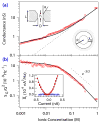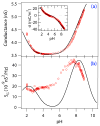Probing surface charge fluctuations with solid-state nanopores
- PMID: 19659110
- PMCID: PMC2865846
- DOI: 10.1103/PhysRevLett.102.256804
Probing surface charge fluctuations with solid-state nanopores
Erratum in
- Phys Rev Lett. 2010 Jul 16;105(3):039902
Abstract
We identify a contribution to the ionic current noise spectrum in solid-state nanopores that exceeds all other noise sources in the frequency band 0.1-10 kHz. Experimental studies of the dependence of this excess noise on pH and electrolyte concentration indicate that the noise arises from surface charge fluctuations. A quantitative model based on surface functional group protonization predicts the observed behaviors and allows us to locally measure protonization reaction rates. This noise can be minimized by operating the nanopore at a deliberately chosen pH.
Figures



References
Publication types
MeSH terms
Substances
Grants and funding
LinkOut - more resources
Full Text Sources
Other Literature Sources
